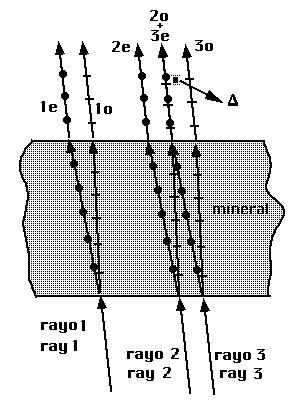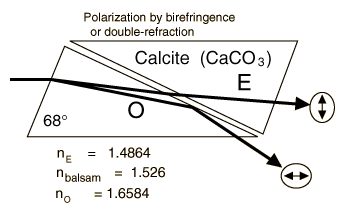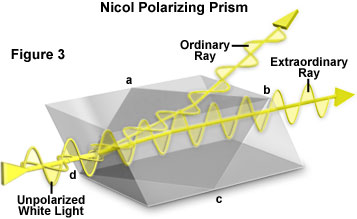What is Nicol Prism?
Nicol prism is an optical device which is used for producing and analyzing plane polarized light in practice.
Principle of Nicol Prism:
Nicol Prism is based upon phenomenon of Double refraction.
Phenomenon is Double refraction:
When a ray of light arrives at an anisotropic crystal, it splits into two rays of polarized light which vibrate in perpendicular planes.

One ray obeys the laws of refraction (ordinary ray) and the other does not (extraordinary ray). Additionally, both present different refractive indices (their directions of vibration are different). When they leave the crystal, both follow parallel paths even though their planes of vibration continue to be perpendicular.
The ordinary and extraordinary component follow different paths inside the crystal, but on leaving the crystal, they follow parallel paths. To simplify matters, we can assume that both components follow a single path although they are vibrating in perpendicular planes.

Construction of Nicol Prism:
- It is constructed from the calcite crystal PQRS having length three times of its width.
- Its end faces PQ and RS are cut such that the angles in the principal section become 68° and 112° in place of 71° and 109°.
- The crystal is then cut diagonally into two parts. The surfaces of these parts are ground to make optically flat and then these are polished.
- Thus polished surfaces are connected together with a special cement known as Canada Balsam.

Working of Nicol Prism:
- When a beam of unpolarized light is incident on the face P′Q, it gets split into two refracted rays, named O-ray and E-ray.
- These two rays are plane polarized rays, whose vibrations are at right angles to each other. The refractive index of Canada balsam cement being 1.55 lies between those of ordinary and extraordinary and 1.4864, respectively.
- It is clear from the above discussion that Canada Balsam layer acts as an optically rarer medium for the ordinary ray and it acts as an optically denser medium for the extraordinary ray.
- When ordinary ray of light travels in the calcite crystal and enters the Canada balsam cement layer, it passes from denser to rarer medium. Moreover, the angle of incidence is greater than the critical angle, the incident ray is totally internally reflected from the crystal and only extraordinary ray is transmitted through the prism.
- Therefore, fully plane polarized wave is generated with the help of Nicol prism.

Nicol Prism as a Polariser:
- In order to produce and analyze the plane polarized light, we arrange two Nicol prisms.
- When a beam of unpolarized light is incident on the Nicol prism, emergent beam from the prism is obtained as plane polarized, and which has vibrations parallel to the principal section.
- This prism is therefore known as polarizer. If this polarized beam falls on another parallel Nicol prism P2, whose principal section is parallel to that of P1, then the incident beam will behave as E-ray inside the Nicol prism P2 and gets completely transmitted through it.
- This way the intensity of emergent light will be maximum.

